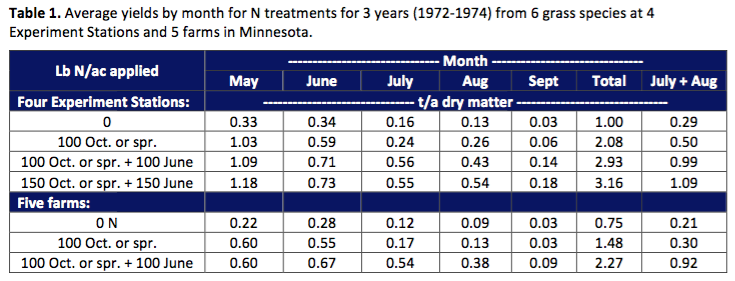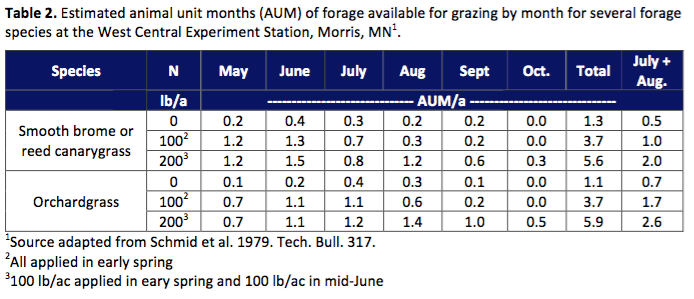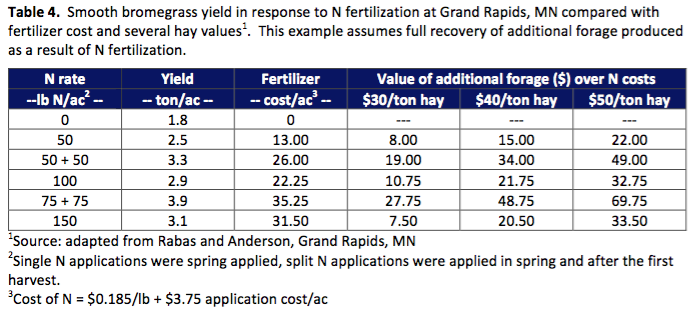Nitrogen Management for Grass Pastures
by Greg Cuomo, University of Minnesota/West Central Research and Outreach Center
In most grasslands, the two factors that most limit growth are moisture (rain) and N. There is not much we can do about the weather; however, we can manage N to improve productivity on pastures. Nitrogen deficiency in pastures is common. It can be seen as you drive down the highway at 70 mph. The lush, dark green growth that surrounds dung piles in many pastures is an indication of N deficiency. When considering N fertilization on grass pastures, decisions need to made regarding if, when, where, the source, and how much N to use. This paper will address these questions to help you determine how N fertility may fit on your farm.
The first question to consider is if N fertilization is necessary. If you currently produce enough forage to meet your grazing and/or hay needs, then additional N is probably not necessary. If forage production from your pastures is less than desired, N might be helpful. Once you have decided to use N on your pastures, the first step is to get a soil test. Soils should be tested by a lab which can make fertility recommendations for your soil and climate. If soils are lacking in P and K, the pastures will not be as responsive to N. Nitrogen fertilization should be part of an overall fertility program.
Most farmers who use N on their pastures, use a moderate amount of N in spring. If pastures are harvested for hay, this is a good way to increase hay production. However, under grazing systems, forage is often in abundant supply in spring, additional growth at this time may not be efficiently used by grazing animals. This can result in poor return from money invested in fertilizer. It may make more sense in a grazing operation to apply fertilizer in mid- to late-June. This way the additional forage production will occur in mid-summer, when additional forage is needed. Nitrogen fertilization research in Minnesota showed that applying N in June increased forage production in July and August 0.3 to 0.7 t/ac (Table 1). Another way to think about increased forage production in summer is in animal unit months (AUMs). Table 2 shows a large increase in July and August stocking potential in response to June N fertilization.
Since many pastures are under-used in spring and over-used in summer, one application of 50- 75 lb N/ac in mid-June may be the most profitable in many pasture systems. Once you apply more than about 75 lb N/ac/year to a cool-season grass pasture, split applications are a good choice. My opinion is that if you are applying 50-75 lb of N/ac/yr, apply it in mid-June to stimulate summer production. If you are applying 100 lb N/ac/yr and spring growth is enough to meet goals, consider applying 50 lb in mid- June and 50 lb in mid-July. The mid-July application would be to stimulate forage growth to be stockpiled for fall grazing. If you are applying 150 lb N/ac/yr or more to a pasture, consider breaking it into three separate applications with 1/3 in spring, 1/3 in mid-June, and 1/3 in mid-July. At all N rates, a plan for efficiently use of extra forage is important.
The method in which pastures will be harvested will also effect N fertilization strategy. Nitrogen management should be different on grass pastures used for hay as opposed to when the pasture is grazed. Three tons of grass hay that contains 12.5% crude protein will remove about 120 lb N/ac. If pastures are grazed, over 80% of the N consumed by livestock is returned to pastures as urine and feces. When pastures are grazed, N fertilization in pastures can be an effective way to increase the total N in pastures. However, N is often not evenly distributed by grazing animals. Grazing for shorter periods with more pounds of animal per acre can help with N (manure and urine) distribution. The next few sections of this paper will contain some background information to help you make informed N fertilization decisions.

How Does N Fertilization Effect Grass Pastures?
Simply put, N grows plant tops (leaves). More plant tops means more forage production per acre. Assuming other nutrients are not limiting, N can increase production and thicken stands.
Although N fertilization has been shown to increase production per acre, it may not lead to better individual animal performance. Therefore, when increasing forage growth with N fertilization you should consider: 1) do you have enough animals to use the additional forage, or 2) where and when will you make hay? An increase in forage production per acre with N fertilization can be particularly beneficial to dairy producers who graze lactating animals. Increased production on acres close to the barn results in less distance for cows to walk between pastures and the barn.
Nitrogen can also affect botanical composition. Generally, N will favor more productive grasses over less productive grasses. For example, in a smooth bromegrass, bluegrass, quackgrass pasture, brome and quackgrass will tend to increase compared to bluegrass with N fertilization.
Nitrogen fertilization can also impact grass/legume mixtures. Nitrogen fertilization tends to favor grass growth. When N is applied to a grass/legume mixture and the pasture is grown for hay, N fertilization tends to favor grasses over legumes. However, under grazing, legumes generally can compete with grasses, even under relatively high N rates.

N Source
One thing to consider with N fertilization is that N can be applied to pastures in several forms. Supplying N to pastures by growing legumes or with animal manure can be an excellent option. Legumes can provide 80-100 lb. N/acre to grasses in a pasture. As mentioned previously, over 80% of the N produced by the legumes will be returned to the pasture through manure and urine.
Legumes can be an excellent source of N for pastures and have a dramatic impact on forage production. Data from the first year of a study at the West Central Research and Outreach Center, near Morris, MN shows that even 200 lb N/ac on cool-season grass pastures (primarily bromegrass) was not as productive as a grass/legume mixed stand (Table 3). The challenge with grass/legume stands comes in managing and maintaining legumes. It is easier to maintain a grass pasture and supply N fertilizer than it is to manage legumes in a pasture. However, as this data indicates, there are real advantages to grass/legume mixed pastures.

Strategic N Fertilization
Producers with many acres of pastures on relatively unfertile land are often hesitant to use N. This is understandable since the cost of fertilizing all those acres would be quite high, and the economic return may not be good. One alternative is strategic N fertilization. Identify areas that have high production potential. These areas tend to have the greatest potential for economic returns from applied N. Hay meadows, areas with better soils and/or areas that contain more productive species may be good choices. By identifying and focusing N inputs on more productive areas, maximum benefits can be obtained while keeping costs reasonable.
Economics
How much fertilization can be profitably applied to pastures can be difficult to determine. Growing more grass does not make fertilization profitable. Remember, for every dollar spent on fertility (or any input), more than one dollar must be made in return. Therefore, fertilizing to grow more forage in the spring and letting get that forage get mature and rank is not profitable. Table 4 contains some economic returns for N fertilization. Nitrogen fertilization is evaluated on a hay equivalent cost. Table 4 assumes all the additional forage grown can be harvested and used. Table 5 is the same information, but attempts to more closely simulate a grazing situation. It assumes that about 60% of the additional forage grown as a result of N fertilization will be consumed.
Summary
There are several questions to consider when considering N fertilization for grass pastures. They include: 1) should you fertilize, 2) when should you fertilize, 3) how much should you fertilize, 4) how will you efficiently use the additional forage, and 5) what should the N source be. Start out by identifying your goals and needs and see if N fertilization can help you become a more efficient producer.





